BY DEBRA KEEFER RAMAGE
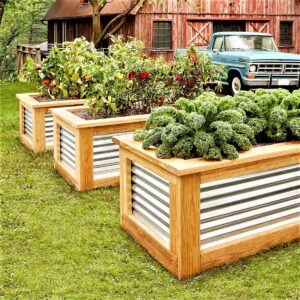
Waist-high raised beds make gardening accessible for all.
Home safe home
These days, for a lot of us, our homes are a refuge from the dangerous world out there. The experience many of us had of “sheltering in place” has possibly given us a new appreciation of the good points as well as the not so good points about our homes.
This month, we’re looking into ideas to make changes or additions to your home that make it a safer place or more healthful place. We’ll also include ways you can upgrade your home even if you don’t own it – either things you can pack up and take with you, or easily reverse when you move, or ways to ensure you don’t end up paying twice by “breaking your lease.” For homeowners, a lot of these ideas will also add value to your home if you’re planning to sell it.
Lighting and windows
New windows can really transform your home. I have experienced this twice so far. In the U.K., my spouse and I updated our 99-year-old home with modern “double-glazing” and then a year or so ago, I replaced all the windows in my aging 1985 senior condominium. Modern technology can allow maximum light with minimum heat loss (or in my case, the more vital air-conditioning loss.) Combine your anti-glare, well-insulated windows with a modern cellular shade, or blackout curtains in your bedroom, for the best combination.
Indoor lighting can make a significant difference in health as well as safety. Migraines and other unpleasant conditions can be triggered by the wrong kind of artificial lighting. If keeping cool in summer matters to you, there is a huge difference in the amount of heat generated by various types of light sources. Motion-sensing strong lights for basement stairs are an important safety measure, as is effective lighting in the kitchen.
Floors, doors, and accessibility
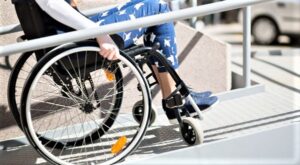
Ramps are not only for wheelchairs.
The surface of a floor – i.e., whether it is hard or soft or carpeted, non-slip or not, and what material – becomes far more than an aesthetic consideration for older people, babies, and people of any age with mobility impairment. I found a wonderful source online for a concept called Universal Design (UD), which is something that grew out of ergonomics, and is vital to both the disability rights community and the aging-in-place community.
UD (aginginplace.org/how-universal-design-creates-a-seamless-aging-in-place-experience) comprises seven “principles”:
• Principle 1: Equitable Use
• Principle 2: Flexibility in Use
• Principle 3: Simple and Intuitive Use
• Principle 4: Perceptible Information
• Principle 5: Tolerance for Error
• Principle 6: Low Physical Effort
• Principle 7: Size and Space for Approach and Use
These principles apply to everything from designing spaces for public use to buying products for your home to designing software and web applications.
Applied to floors, UD tells us to opt for flooring such as cork, tiles or Marmoleum™ that don’t have edges, level changes, high thresholds, or nap-like carpet. (Carpet might seem like a good choice, until you get a wheelchair or walker. It’s hard to roll wheels on carpet. Also, with small children or animals, there are going to be spills.) If you do want carpet, get a low-nap type.
Floors also mean levels. All on one floor is ideal for the elderly or disabled or young children, but not always possible. Still, you can provide alternatives. Build a ramp to make rolling your baby’s stroller into the house easier, but leave it there for when grandma comes to visit. Older people find it easier to use a ramp even if they are walking. If designing a home with stairs, make them wide enough that you can add a stairlift if it ever becomes necessary.
Speaking of width, the width of doors, both exterior and interior, is a consideration in UD. Besides being more inviting in appearance, and accessible to all, you’ll appreciate a wide door when you decide to rent a grand piano or install an indoor hot tub.
Making kitchens less dangerous
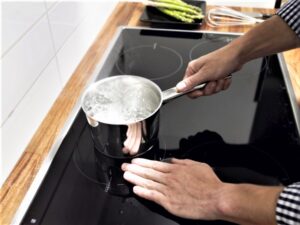
Induction cooktops protect you from burns.
Kitchens can be dangerous. If you’re updating your kitchen, consider safety, health, and UD in your plans. Here are some random home safety statistics I picked up on the internet:
• 90% of kitchen cloths failed cleanliness tests.
• Foodborne disease causes 76 million cases of illness in the United States alone, according to the centers for Disease Control and Prevention (CDC).
• Over 150,000 kitchen fires every year are caused by cooking equipment – with 460 fatalities.
• Lacerations from kitchen tools account for 42% of hand injuries that are seen by ER professionals.
• A home without a fire alarm is twice as likely to have a fire, according to the U.S. Fire Administration.
• Unattended cooking equipment accounted for 45% of home fatalities from 2002 to 2005.
• 34 fatal burn injuries occur each year from scald burns out of the kitchen.
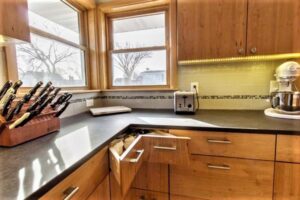
A detail from a kitchen remodel — photo from Castle Building and Remodeling
• After age 65, falling becomes the leading cause of death in the home, with many slip-and-fall accidents occurring on wet kitchen floors.
One modern innovation, though pricey, is probably worth it – induction burners on your stove or counter cooktop. Induction burners prevent burns by directly conducting heat into the material of the cooking vessel.
Kitchen remodels often turn into bigger projects than you think. Although the best contractors will let you save money by doing part of the work yourself, it’s probably best not to go it alone, especially with kitchens and bathrooms.
Bathtubs, saunas, and luxury showers – oh my!
My favorite part of house remodeling is the bathroom. It makes such a difference in your day-to-day life if you can add these luxury self-care touches to your home. Referring again to my home in
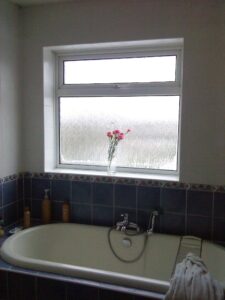
The author’s own custom designed bathtub
England, which we did two big remodels on, I replaced a repellent chocolate-brown fiberglass shallow tub with a fully enclosed clawfoot tub and ceramic wall tiles floor to ceiling and even in the deep window well over the new tub. It was my little retreat to paradise every day.
A simple upgrade might be a rainfall shower. Although it has long been conventional wisdom that showers are for quickly getting clean and only bathtubs are for relaxing, researchers (and the realtors who listen to them) are finding more and more people get relaxation in the shower. You can add a bench inside and have a seated shower. You can use a massaging, hand-held shower head.
Another conundrum of aging is if you at some point have to give up your deep soak in a clawfoot tub, because it’s no longer safe or even attainable. Walk-in bathtubs could solve this problem, but the jury is still out on whether they add to or detract from the resale value of your home, and like jetted hot tubs (which they sort of are) they can have cleaning and maintenance issues.
A major upgrade (if you have the space for it) could include a sauna, a steam room, or the aforementioned hot tub. Saunas or hot tubs can also
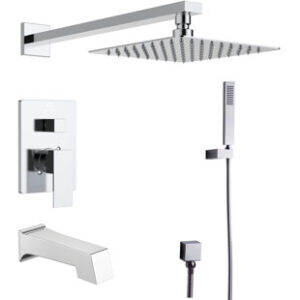
Simple fittings for a rain shower
go outdoors if you don’t have the space indoors. You can even get a mobile sauna and take it with you on road trips or up to the lake.
The joy of decluttering
Decluttering is something you will have to do if you remodel or sell your home. So why not do it now, while you’re still thinking about whether to do those things or not? Although I have never managed to declutter myself, many people have rhapsodized to me about how liberating and life-altering it is. Hiring a helper makes it less overwhelming.
Better gardens
The exterior of your home and surrounding land is where you can really make a significant difference. Devoting part of your lawn to raising flowers, herbs, pollinator attractors or food crops has a substantial impact on your health in
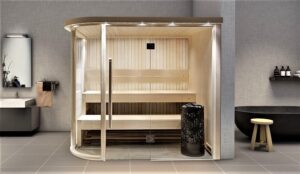
An indoor sauna in a huge bathroom — photo from Voyageurs
Saunas
many ways. If you want to do this, but have mobility concerns, consider a raised bed, especially one raised high enough that you can tend it standing. Here again, a consultation with a specialist may help, which could be a landscape business, a county master gardener, or just the staff at a local garden center, of which we have many.
Home improvement for renters
If you’re renting, you can still make changes to improve your home. If you have a specific need, such as a new or temporary disability, there are agencies that can help you negotiate with your landlord, and also possibly help pay. In general, though, options range between working with your
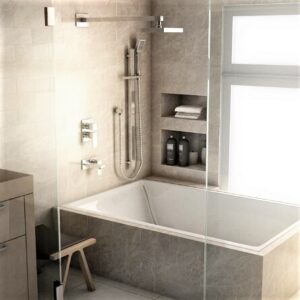
A beautiful bathroom remodel with a rain shower
landlord to doing reversible changes and putting it back the way it was if you move out, or maybe a little bit of both. You can find some ideas here www.moneytalksnews.com/9-ways-to-remodel-your-rental-without-breaking-your-lease.
WTF? ( Where To Find?)
How do you find any help you may need to do the remodel or upgrade of your dreams? Or just to make a major purchase for your home? Google will only get you so far. Here are some ideas.
• Using a directory or the internet, find a contractor who gives free or affordable consultations.
• For a decluttering expert, check ads in local papers, classifieds and actual bulletin boards.
• If you’re thinking of selling, consult your realtor about what helps with resale values.
• Consider contacting volunteers at AARP, a disability
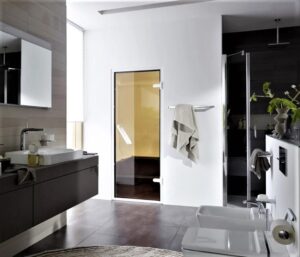
Your own steam room, the ultimate luxury
advocacy group if applicable, or the VA if you are a veteran.
• Use your public library to find resources. Ask a librarian for help to get you started.
• Ask your neighbors, via email on e-democracy or NextDoor, or on a neighborhood Facebook Chat group if you have one, about their experiences doing remodels and working with local businesses.
• Talk to personal friends and family who either work in the industry or have done a remodel themselves.























